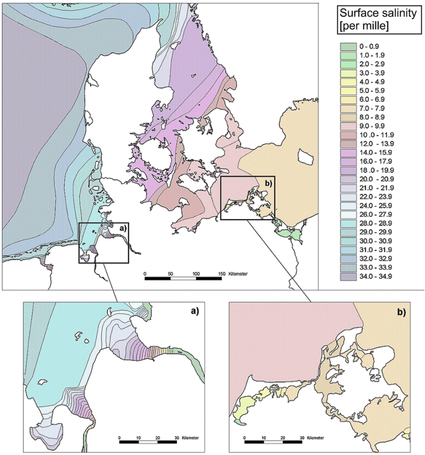Salinity is a crucial ecological factor significantly influencing the composition of organisms in aquatic environments and determining plant growth in both water bodies and on adjacent land. Plants adapted to salty conditions are termed halophytes, with those tolerant to residual sodium carbonate salinity referred to as glasswort, saltwort, or barilla plants. Organisms, mainly bacteria, thriving in highly saline conditions are classified as extremophiles or specifically halophiles. An organism able to endure a wide range of salinities is known as euryhaline.
Determining salinity and its definition present challenges due to the intricate composition of natural waters, comprised of diverse elements (which exist in different molecular forms - and their chemical properties are influenced by factors such as temperature and pressure, making accurate measurement complex).
To address these complexities, measurements of salinity often focus on the summation of masses of specific dissolved chemical constituents, referred to as solution salinity. For practical applications, this summation typically involves eight major molecules and ions in natural waters (NaCl, Kcl, MgSO₄, Cl-, HCO₃-, CO₃²⁻ , SO₄²⁻ , CaSO₄, ). The prominence of major ions in shaping the inorganic composition is observable in most natural waters, although exceptions arise in specific cases. In common salinity descriptions, dissolved gases are generally excluded. However, CO₂, which can undergo partial conversion into carbonates and bicarbonates when dissolved, is occasionally included.
Salinity units are:
-
Parts Per Thousand (ppt) or Parts Per Million (ppm): Some of the most classic units for salinity measurement are ppt or ppm. They represent the number of parts (in mg) of salt per thousand parts of water (in the case of ppt) and per million parts of water (for what concerns ppm).
For instance, a salinity of 35 ppt means there are 35 parts of salt for every 1000 parts (1000 mL, which is 1L) of water; since ppt is essentially one thousandth of ppm, it means that, if we want to convert a value from ppt to ppm, we'll need to multiply this number per one thousand:35 ppt = 35 x 1000 ppm = 35000 ppm
-
Practical Salinity Units (PSU): Practical Salinity Units (PSU) is a dimensionless unit closely related to conductivity. In many cases, 1 ppt is considered approximately equal to 1 PSU. It's mainly used for oceanographic studies and marine science.
-
Grams per Kilogram (g/kg): Expressing salinity in grams per kilogram (g/kg) provides the mass of salt per kilogram of water. The conversion is straightforward, as 1 g/kg is equivalent to 1 ppt (and, consequentially, to 1000 ppm).
-
Percentage (%): Percentage salinity is another common expression, representing the proportion of salt in the total solution. To convert percentage to ppt, simply multiply the percentage by 10. For example, 3.5% salinity is equal to 35 ppt.
-
Electrical Conductivity: Salinity is often inferred from electrical conductivity, measured in Siemens per meter (S/m) or Microsiemens per centimeter (µS/cm). The conversion from electrical conductivity to salinity involves calibration and correlation equations specific to the measurement method and environmental conditions.
These units are used differently, based on the field of application and the researcher's needs:
-
Overall Ion Content: If you are interested in an overall assessment of ion content without specific identification, EC is suitable.
-
Specific Ions: If you need to quantify the concentration of specific ions, ppt, PSU, or ppm may be more appropriate.
The measurements we take in the greenhouse use the EC as unit but, as mentioned in the introduction, most of the articles on halophytes express salinity in ppm. So, how do we convert ppm into dS/m? This process requires additional information on the specific ions present in the solution: you typically need calibration data or a conversion factor specific to the solution you are measuring. The conversion factor depends on the types of ions present and their contribution to the overall conductivity.
The general formula is:
ppm = k × EC
Where k is a conversion factor specific to the solution.
The value of k is determined through calibration or referencing tables and literature specific to the solution. Different substances have distinct conversion factors, emphasizing the need to know the solution's composition for accuracy.
This conversion is an approximation and may vary based on the specific ions, concentrations, and temperature. Some EC meters have built-in conversion factors. Always check your meter's documentation.
So, when it comes to halophytes research, you need to seek for the salts dissolved in the solution that's used for watering the plants.
Most of the time, it's NaCl: as 10 mM NaCl has an EC of almost exactly 1.0 dS/m, and as it is the most common salt in solution in ground or river water, a ‘rule of thumb’ is to multiply the EC by ten to equate it to salt molarity.
Anyway, it's important to remember that it is not an accurate conversion. For more precise conversions without knowing the specific ion composition, laboratory testing or measurement with instruments calibrated for the specific solution may be necessary.
